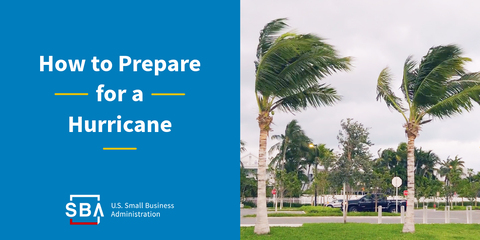
SBA releases hurricane season information guide
The U.S. Small Business Administration offers communities disaster mitigation and assistance.
Taking into account that hurricane season is just around the corner, the Small Business Administration (SBA) published a series of recommendations and information of interest so its affiliates can begin to prepare to face possible weather adversities.
The SBA, which continues to prioritize equitable support to affected communities through business preparedness, mitigation, and disaster assistance efforts, highlighted the importance of preparing before disaster strikes, underscoring the need to support individual homeowners and renters affected by natural disasters across the country, making sure they have the recovery help they need, as well as the tools to build resilience.

Isabel Guzmán, Administrator of the SBA, pointed out:
Our small businesses depend on neighborhoods to survive and thrive as neighbors are their customers and employees. That is why the SBA helps entire communities - homeowners, renters, nonprofits, and businesses - become more resilient and recover swiftly from disasters.
Prepare for the Imminent
According to the SBA briefing guide, natural disasters are becoming more devastating and unpredictable, coming faster, more frequently, and often exhibiting an abrupt shift in complexity and scope.
“In 2020, the United States suffered 22 separate billion-dollar disasters —the most in our history— but experts in the space expect that number to continue to climb. Fighting climate change and preparing America to adapt to its impacts has been and will remain a priority for the Biden-Harris Administration - and supporting that readiness is a critical component of the SBA’s work under Administrator Guzmán,” it is highlighted by the SBA.
RELATED CONTENT
SBA Disaster Program Milestones
These programs have been expanded and scaled in the face of new challenges, among which the following stand out:
- Last year, the SBA approved more than $2 billion to help residents and businesses in all 50 states and five territories recover from natural and other physical disasters unrelated to the pandemic, including multiple hurricanes, floods and wildfires, all of which have been rising in frequency and severity at significant physical, human, and economic costs.
- Two of the critical SBA programs funded in part by President Biden’s American Rescue Plan, the COVID Economic Injury Disaster Loan (EIDL) program and the Shuttered Venue Operators Grant (SVOG), provided a lifeline to millions of small businesses across America.
- Through COVID EIDL, more than $378 billion was put directly into the hands of over 3.9 million entrepreneurs from our hardest-hit sectors. The COVID EIDL Advance Programs put an additional $7.6 billion, approximately, in grant funds.
- The Shuttered Venue Operators Grant program helped save nearly 13,000 businesses in the arts industry, collectively awarding them more than $14.2 billion. Additionally, over $800 billion was distributed through the Paycheck Protection Program and $28.6 billion through the Restaurant Revitalization Fund.
- As of June 1, 2022, SBA personnel are responding to two open Presidential disaster declarations, 10 SBA Administrative disaster declarations, six Governor’s certifications, 108 Secretary of Agriculture declarations, and one Military Reservist Economic Injury Disaster Loan declaration.
SBA Disaster Recovery Relief
SBA disaster relief loan programs help communities get back on their feet quickly by:
- Funds received from SBA disaster loans can be used by property owners to build back better, stronger, and more resilient.
- SBA disaster loan funds can be used to cover insurance deductibles, refinance an existing mortgage, pay for mitigation and protective upgrades, relocate to a safer and lower risk area, and more. And low, fixed interest rates amortized over 30 years for low monthly payments offer an affordable way for property owners to fully repair/replace their disaster losses not covered by other recoveries.
- Borrowers using SBA’s physical disaster loan programs are also eligible for up to 20 percent of their total physical losses, as verified by SBA, to incorporate additional protective measures to mitigate future damage and losses against the next disaster.
- SBA also offers non-pandemic related economic injury disaster loans to help small businesses, small agricultural cooperatives, and most private nonprofit organizations located in a declared disaster area rebuild after suffering a substantial loss.
How to Prepare for Hurricane Season?
Here are some tips businesses can use for this year's hurricane season:
- Establish a communications plan and subscribe to local emergency management alerts.
- Protect vital information in the cloud.
- Review insurance coverage, consider business interruption insurance, and take a video inventory of property and assets.
- Complete facilities and operations planning; consider e-commerce solutions or temporary alternative locations to resume operations quickly and evaluate supply chains.
- Engage in pre-disaster contract development opportunities.
- Practice and test your plan with managers and staff.
“Through greater emphasis on business preparedness operations for our small businesses, equitable distribution of disaster funding and attention to recovery efforts in historically underserved communities, and by improving upon current partnerships while identifying new collaboration opportunities with on-the-ground organizations, the SBA is uniquely positioned to help our small businesses, homeowners, renters, and nonprofits weather any storm,” it is underlined.
Disaster loan questions can be emailed to DisasterCustomerService@sba.gov or directed to the SBA Customer Service Center at 1-800-659-2955 (7-1-1 for the deaf or hard of hearing). You can find information about the SBA's major loan programs, income growth opportunities, and technical assistance by clicking here.











LEAVE A COMMENT: